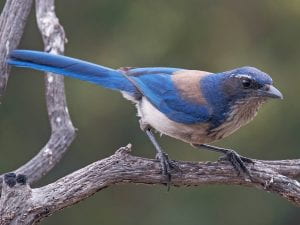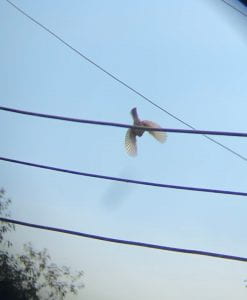Locations: 1637 Menlo Ave, Arcade US-CA (38.5948,-121.3499) (26 m)
Site Description: This week I some birding in my neighborhood — mainly my front and back yard. Overall, the area is pretty flat but the trees being tall adds to the elevated aspect of birding. There are various tall trees in my neighborhood with lots of branching. They are also quite widespread so it can be hard to see the birds as they fly in and out of the branches. Some bushes and shrubs are at ground level, but I did not see many birds on the ground today. I saw birds mainly in the sky or landing in higher up trees or powerlines. Overall, the birds seen were both small and medium-sized. There were lots of bird calls and chirping, and it was difficult to get a visual on the birds even if I could hear where they were coming from due to all of the branching. Sometimes there were times where there were lots of bird activity while other times were extremely quiet. The neighborhood was mainly quiet but towards the end of my time birding, there was some gardening occurring nearby and it was harder to hear the birds. I also birded in my front yard where there were mainly tall trees. Most of the trees were tall and heavily leafed. Some were just branches with no leaves. I saw about 7 different taxa and the key bird species seen included: Mourning Dove, Black Pheobe, California Scrub-Jay, American Crow, Oak Titmouse, Tree Swallow, Yellow-rumped Warbler and Anna’s x Rufous Hummingbird (hybrid).
Species Account: California Scrub Jay was an interesting species I saw this time birding and I had seen previously birding in this area as well. I saw the California Scrub Jay land on the power pole. When the jay flew over, it sounded like a vibrating noise. It was a fairly larger compared to other song birds. Its tail is long and blue colored. It sized to be between a robin and a crow (All About Birds). California Scrub Jays are known to be assertive and loud and are often found to be stationed high in trees, wires, or on posts (All About Birds). I did not really hear it They are known to be omnivorous and eat acorns and seeds, and forage both on the ground and in trees — alone or with other family members (Audubon). They are known to breed in isolated pairs, not cooperative flocks (Audubon). They lay 3-7 eggs per brood and babies are fed by both parents (Audubon). They are known to be found year-round in California (Sibley).
Narrative: I went birding for about an hour in neighborhood. I started birding around 1 pm and the weather was very nice. It had been raining the past few days so I was worried I would not see many birds but it was a pretty loud day in regards to chirping. There was no wind/breeze and it was pretty warm outside. It was overall a clear day. I mainly was looking in the branches and trying to listen for chirping to locate the birds. I not see many soaring birds as I only saw one turkey vulture. I was able to identify it by its wing shape and coloration as it soared over. I also noticed this time that shadows of a bird quickly flying over alerted me to its presence. This happened a couple times and helped me identify a California-Scrub Jay and a couple of Tree Swallows. The small birds–especially the tree swallows– were also very quick to flit from branch to branch and usually quickly flew away. The tree swallows would follow each other closely and flew with undulating flight. I also spotted a couple of Oak Titmouse on the power line in my yard. They had a very trill-like sound. I always see a Yellow-Rumped Warbler in my yard and usually only see one when I do see it. I am not sure if it is always the same one. I also saw a Black Pheobe fly into a large oak tree and its song sounded very similar to the Sibley recording. I noticed the American Crow to have the loudest shrieking chirp. The one hummingbird I saw was seen on a tree that had no leaves. It had an overall green colored body with a white/green colored chest. Its head was also mainly green. It also had darker colored wings (either a black stripe or overall black wing). For that reason and according to the Sibley Guide, I thought it may be an Anna’s and Rufous Hybrid. The lighting made it a little difficult to be 100% confident of its coloration, but this ID matched what I saw the best in my opinion.
Additional Photos or Media: https://ebird.org/checklist/S67115424







Very cool regarding the potential Anna’s x Rufous Hummingbird! Looking at your photo and comparing it to the Sibley guide, I can see why you think it could be the hybrid – especially the clearly white belly and white throat strip. As Sibley notes, because of hummingbird’s structural coloration, they can look very different depending on how the light strikes them, which is usually why some birds look ‘wrong’ compared to the book. That said, based on your photo I think it could be a hybrid! They are rare, but rare things do get seen!